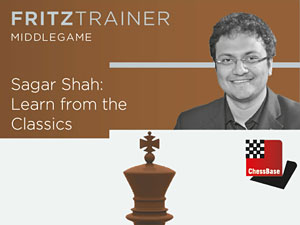Sagar Shah: Learn from the Classics
Review - part 1
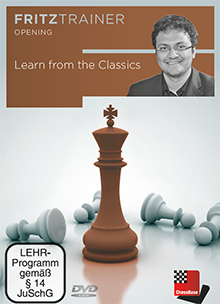
We have all heard it repeatedly: "study the classics!" Ever since I started playing, people have been advising me to first study the ABC of chess – the games of Alekhine, Botvinnik and Capablanca. Following their advice, I have gone through many classical games. However, I always wondered how the ideas used in the games played decades ago can be implemented in my own games. I am aware that top players like Kasparov, Carlsen and Anand have given immense importance to the study of the classics. When Anand won a brilliant game against Aronian in Wijk and Zee 2013, chess fans were thrilled! After the victory, Anand confessed that the game which kept on coming to his mind was the famous classic Rotlewi-Rubinstein! Such comments by my chess idols fascinate me, but its implementation in my own games is something which I still do not find easy.
Surfing the ChessBase website for news and the ChessBase shop for new products has now become a part of my daily routine. A couple of days ago I was doing the routine check-up and found a new ChessBase DVD: Learn from the Classics by a prolific columnist of this news page, Sagar Shah. With his wonderful and easy-to-understand write-ups on chess Sagar has succeeded in drawing a lot of attention of not only the professional players but also of a lot of amateurs and chess lovers across the world! I started viewing the videos immediately after its launch and hoped that, just like his columns, his teaching too will unleash some wonderful chess secrets to me!
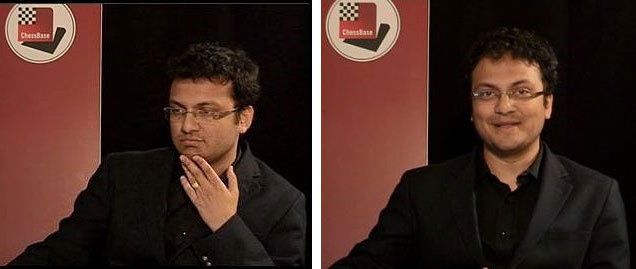
Many chess players in India say that they have been inspired by Anand and have taken up chess.
I would not be surprised if people soon tell me they got attracted to chess reading Sagar’s articles!
What impressed me a lot was Sagar’s claim that he would take me through a ‘process’ by which I could actually gain from the study of classics. This was exactly what I was looking for — not one or two ideas but the entire process!
This DVD could also be named: Chess Explained Move by Move or Chess Made Easy! I expected Sagar to quickly flip through the opening stage, and come straight to the middlegame theme which he wanted to show. However, what makes his classical lessons unique is that he does not start explaining from move twenty but does it right from the start, making it very easy for players of all levels to grasp the ideas from move one!

A theoretical position from the Nimzo- Indian Defense. Fischer employed a very important strategic idea: he gave up his bishop with 6...Bxc3 and then placed his pawns on the opposite colour of his remaining bishop with d6 and e5
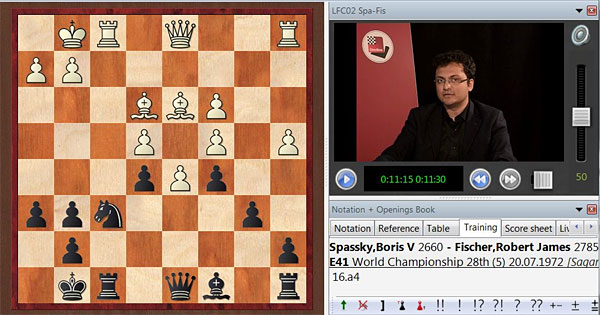
White is threatening a5. How did Fischer deal with this threat?
Fischer came up with an excellent move, 16...a5, which looks anti-positional at first glance, as Black is accepting a backward b-pawn in an open file. However, the author explains that in chess you give something and you take something! Fischer accepted the b6 weakness in return for fixing the a4 pawn and setting it as a target with Bd7. It was important to stop White’s a5 which would terrorize Black completely.
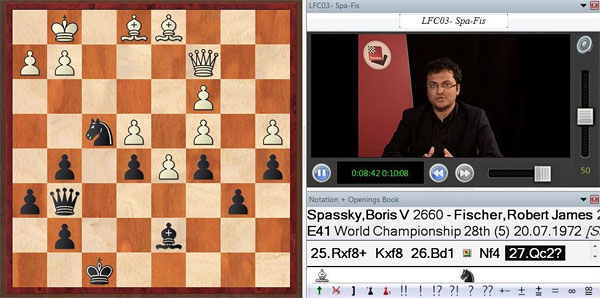
Time for the final blow by Fischer. Simple and sweet!
Yes, 27...Ba4 is decisive. Now that we have divided the Fischer game into three important parts: the opening, the middlegame and the final blow, isn’t it easier to remember the game? Did you realise what we just did? We broke up the game into critical moments and registered the ideas in our brain!

Sagar shows that chess can be child’s play! You just have to know the ideas and use them: that simple!
He had learnt an idea from Fischer and effortlessly played 16...a5 here!
The name of the DVD deceived me! I thought that the Indian International Master will be giving a one-sided lecture on the classics and I will passively watch it and try to keep one or two ideas in my mind. So when I started the lessons I was ready with cold drinks and snacks to keep me occupied while watching the four hours and forty-five minutes of video recordings! How wrong I was! Like a true chess player, the author had foreseen the laid-back approach of viewers, and had planned his DVD to keep me on my toes by continuously asking questions, right from the word go! He insisted that I pause the videos and made sure to actively involve me in the learning process!
In my growing up years I invested a lot of time learning the minority attack so common in the Queen’s Gambit Declined Exchange Variation and in the Caro Kann Defense. Shah shows the two most important classical games in this pawn structure, where the side having a pawn minority dares to attack the majority! Once you learn it from Sagar the ideas become crystal clear!
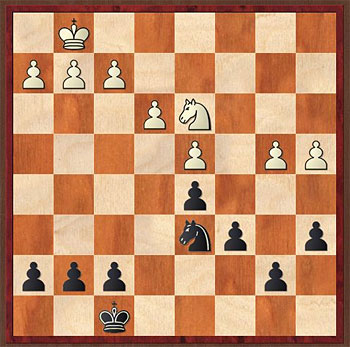
The author beautifully explains the minority attack to his viewers. In the above diagram, he has removed all the other pieces to explain the importance of the strong knight on d6 which stops White’s b5 and supports the b7 pawn. In some cases, the knight can jump to c4 after a preliminary b5.
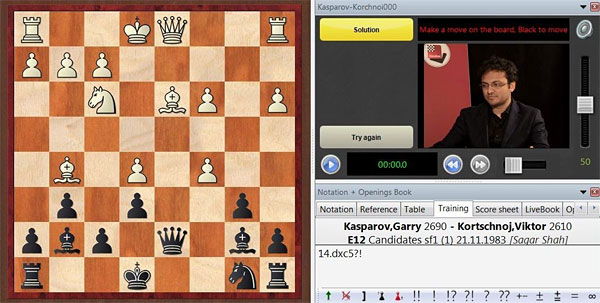
The only game in more than forty games that Korchnoi was able to beat Garry!
Kasparov has just captured 14.dxc5. What will you play as Black?
Korchnoi was not greedy to recover the pawn and played 14...0-0! After 15.cxb6 axb6 an interesting position was reached.
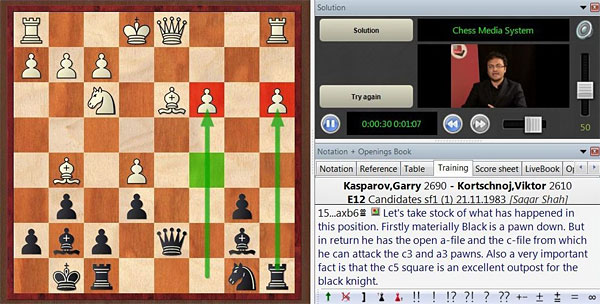
A common idea in the Queen’s Indian Defense! Black has sacrificed a pawn for interesting compensation.
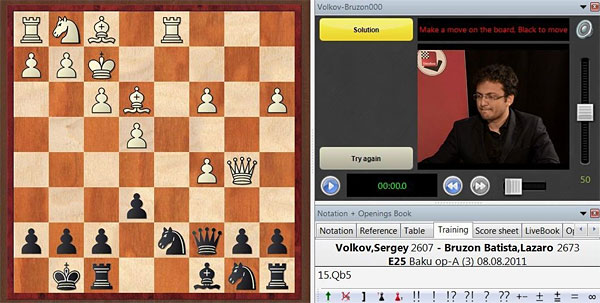
Once you know the ideas, playing chess becomes very easy! Are you familiar with the idea Black used here?
Of course, you are right! Bruzon used the same idea as in Korchnoi’s game - 15...b6! Black sacrifices a pawn to get play along the a and c-files.
– Part two with more instructive examples to follow soon –
 Learn from the Classics Learn from the Classics
By IM Sagar Shah
Languages: English
ISBN : 978-3-86681-500-1
Delivery: Download, Post
Level: Tournament player, Professional
Price: €29.90 or €25.13 without VAT (for Customers outside the EU) $27.06 (without VAT)
Wise and successful players of the game have always told us to study the classics – games by the great masters of the past. But in this age of cutting-edge opening theory, preparation and engines, is studying the classics really that helpful?
On this DVD, Sagar Shah doesn't merely preach. First, he shows you classical games of great legends such as Petrosian, Botvinnik, Fischer, Korchnoi and Kasparov, looking at typical patterns and ideas from the middlegame. The author then goes on to explain how you can use these ideas in your own battles – by showing you examples of applied classical knowledge from his own games!
As well as looking at the middlegame, Sagar also focuses on the opening. The information explosion has ensured that opening theory continues to evolve at a rapid pace. The author shows that playing through the classics can help us establish a strong and stable feel for the initial phase of the game, and analyzes the opening duel between Botvinnik and Petrosian from their World Championship match in 1963. Going over these games will give you an excellent idea of how the classics can be used to prepare your own openings.
Order Sagar Shah's Learn from the Classics in the ChessBase Shop |
